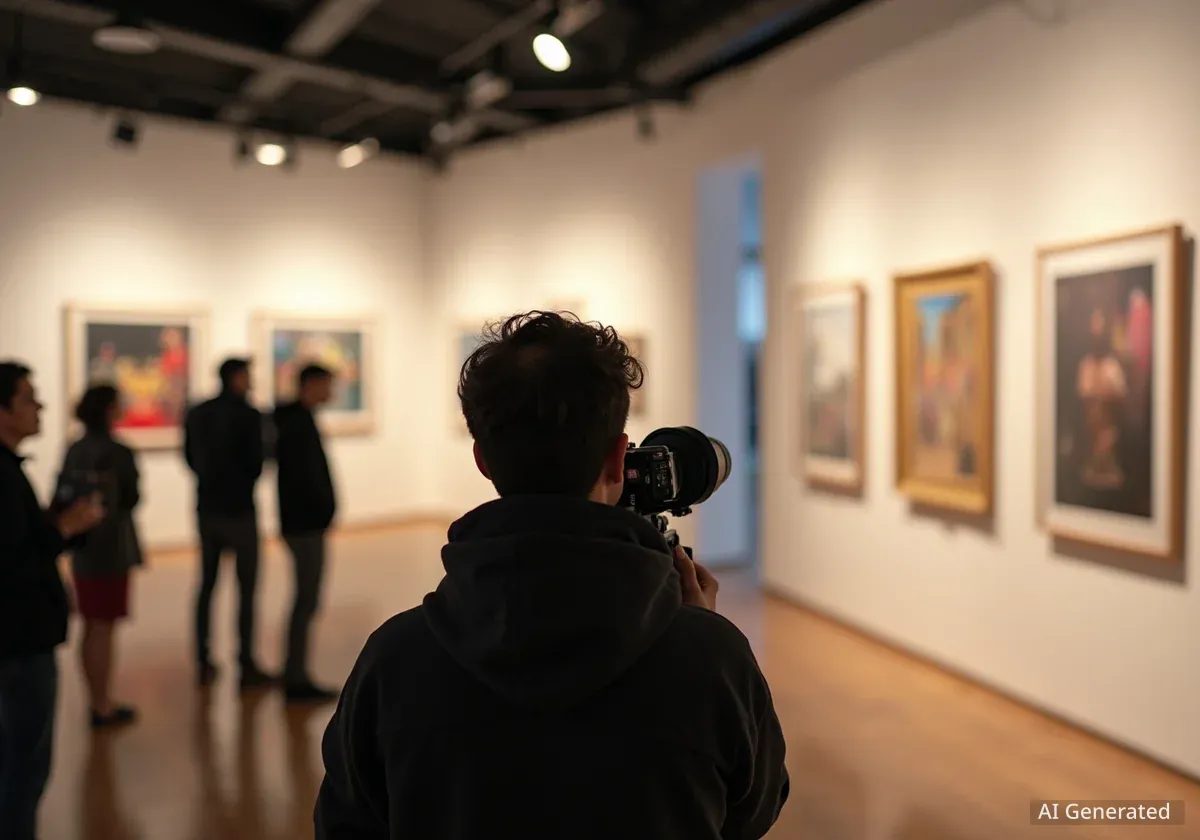Eight years ago, Amy Sherald was a name largely unknown in the broader art world. That changed dramatically when she was chosen to paint the official portrait of Michelle Obama. Today, Sherald, at 52, is recognized as one of America's most significant contemporary painters. Her work, characterized by its unique portrayal of Black Americans with gray-scale skin tones and direct gazes, challenges conventional perceptions of identity and representation in art.
Sherald's rise to prominence has been marked by both critical acclaim and personal challenges. Her distinctive style and powerful subjects have garnered her major museum retrospectives, cementing her place in American art history. Despite recent controversies, including the cancellation of a Smithsonian exhibition, Sherald continues to create impactful art that invites viewers to engage deeply with her subjects.
Key Takeaways
- Amy Sherald gained international recognition after painting Michelle Obama's official portrait in 2018.
- Her signature style features Black American subjects with gray-scale skin and direct gazes.
- Sherald's work explores themes of identity, presence, and American patriotism.
- She recently canceled a major exhibition at the Smithsonian due to concerns about potential censorship.
- Sherald's personal journey includes overcoming a life-threatening heart condition and receiving a transplant.
The Power of the Gaze in Sherald's Portraits
In Amy Sherald's paintings, her subjects, primarily Black Americans, look directly out from the canvas. This direct gaze is a defining characteristic of her work. It creates an immediate connection with the viewer. The subjects appear confident and present, often against minimalist backgrounds or in vibrant, bold settings.
Anderson Cooper, a 60 Minutes correspondent, noted this consistent element in her art. He asked Sherald about the significance of this direct look. Sherald explained that these portraits are not meant to be confrontational. Instead, they are designed to be present. They invite viewers to sit with them and engage in an exchange.
The subjects in Sherald's art are depicted as ordinary people doing their jobs, being beautiful, and being colorful. Yet, Sherald emphasizes that they also have important work to do in the world. This work, she suggests, is achieved simply by their presence and by meeting the viewer's gaze. Their silent stare communicates a powerful message.
"They don't have to say anything. But every time you look at that portrait, something is happening inside of you," Sherald stated.
This internal reaction is central to Sherald's artistic intention. Her paintings aim to provoke thought and feeling, fostering a deeper understanding of her subjects' humanity.
From Obscurity to Art World Stardom
Before 2018, Amy Sherald was not a household name. Her selection to paint Michelle Obama's portrait propelled her into the global spotlight. This commission fundamentally altered her career trajectory. The portrait, titled "Michelle LaVaughn Robinson Obama," was unveiled in 2018 and immediately made headlines worldwide.
Sherald acknowledged the immense significance of this project for her career. She admitted that she focused solely on the painting process to avoid being overwhelmed by the pressure. Her dedication allowed her to stay present in the moment and complete the historic artwork.
The dress in Michelle Obama's portrait holds particular meaning for Sherald. She describes being deeply in love with its colors: red, pink, yellow, black, and gray. Sherald intended the dress to carry symbolic weight, almost functioning as a painting within the painting itself. This detail highlights her meticulous approach to every element of her compositions.
Artistic Milestones
- 2018: Unveiled official portrait of Michelle Obama.
- 2020: Painted a portrait of Breonna Taylor.
- 2023: Major retrospective "American Sublime" at the Whitney Museum of American Art.
- 2025: Scheduled exhibition at The Baltimore Museum of Art after Smithsonian cancellation.
The "American Sublime" Exhibition
Sherald's exhibition, "American Sublime," toured prestigious institutions. It was displayed at the San Francisco Museum of Modern Art and the Whitney Museum of American Art in New York. Sarah Roberts, the show's curator, emphasized the unique quality of Sherald's work. She noted that cameras struggle to capture its true essence.
Roberts described a "luminescent quality" and a "majesty and tactility" that are only fully appreciated when viewed in person. This technical skill is a hallmark of Sherald's painting. It sets her apart and contributes to the powerful impact her art has on viewers.
Sherald's style falls under American Realism. This artistic movement depicts ordinary American life. However, Sherald reinterprets it. She creates images that speak to contemporary America. Her work explores ideas of freedom, individualism, and expression. She reimagines traditional American archetypes like the cowboy or the beauty queen, ensuring that her vision of America includes everyone.
Sarah Roberts explained, "She's reimagining them, and redeploying them to make sure that that idea of America includes everyone. Everybody has a seat at the table? A place on a museum wall."
A Defining Moment and Personal Journey
Amy Sherald's artistic path began with a pivotal moment during a class trip. As a teenager in Columbus, Georgia, she visited a city art museum. There, she saw a painting by American artist Bo Bartlett. It featured a Black man. Sherald realized she had never seen a Black person depicted in a painting before.
This realization was a profound awakening. "I thought, 'I want to do this, too,'" Sherald recalled. This moment solidified her decision to pursue art. Her parents, Amos and Geraldine Sherald, had hoped she would become a doctor. However, Sherald chose art, dedicating over a decade to painting by day and working as a waitress at night.
Her journey was not without significant personal challenges. In 2004, while training for a triathlon, Sherald was diagnosed with a rare heart condition. Doctors warned her against activities that would elevate her heart rate due to the risk of a tachycardic episode. Eight years later, she collapsed and spent months in the hospital. At 39, she received a heart transplant.
The Gift of a New Heart
The donor was a young woman named Kristin Lin Smith. Sherald explained that for the first five years after the transplant, she constantly thought about the donor's heart. Now, she has moments where she remembers Kristin, especially when doing something she wouldn't have been able to do before. Sherald commemorates these moments on Instagram using the hashtag "#adventuresofKristinandAmy." She also adds a small heart symbol when she signs her name, ensuring Kristin lives on in her art.
The Gray Scale: A Deliberate Choice
Sherald's studio in New Jersey is where she creates about half a dozen new paintings annually. A unique aspect of her technique is her use of gray scale for skin tones. She mixes her own paints, and a wall in her closet holds numerous shades of gray specifically for rendering skin.
Initially, Sherald simply liked the aesthetic of gray. It reminded her of old family photographs, including one of her maternal grandmother. However, her choice to use gray skin tones evolved into a deeper artistic statement. She believes it offers viewers a different entry point into her work, encouraging them to pause and consider something beyond immediate racial identification.
"I think that it offers the viewer an opportunity to pause and consider something else before we get to that," Sherald said, referring to the gray skin tones.
She suggests that if her subjects had brown skin, that might be the first thing people noticed. Sherald notes that people often categorize others based on phenotypes—physical characteristics like eyes, nose, and lips. By using gray, she seeks to bypass this initial judgment, allowing the viewer to connect with the subject's humanity first.
Sherald admitted that she initially feared painting brown people. She worried her work would be marginalized and confined to a "Black corner" in the art world, preventing it from conversing with other artists' work. This fear led to her deliberate and now iconic stylistic choice.
National Recognition and Controversies
Sherald's paintings now command significant prices, with some selling for as much as $4 million at auction. Her work is often compared to American Realism masters like Edward Hopper, Andrew Wyeth, and Norman Rockwell. Sherald welcomes these comparisons. She sees it as achieving her goal as a Black woman artist: to be recognized alongside these established figures. "I'm in the room with the guys," she noted.
Despite her success, Sherald recently faced a controversy involving a planned exhibition at the Smithsonian's National Portrait Gallery. The show, also titled "American Sublime," was canceled by Sherald in July. She stated concerns that museum officials, under pressure from the Trump administration, intended to censor a painting.
The painting in question depicted a trans person posing as the Statue of Liberty. Smithsonian officials reportedly wanted to display it alongside a video to "contextualize the piece." Sherald viewed this as unacceptable contextualization, deviating from her original artistic intent. The White House, which had criticized the Smithsonian for being "too woke," applauded Sherald's cancellation, calling the painting "divisive and ideological."
Sherald maintains that her work is not inherently political in its conception. However, she acknowledges that once it exists in the world, it can become political. "It can be art on Monday and political on Tuesday," she commented. Following the cancellation, The Baltimore Museum of Art offered to exhibit "American Sublime." The show is scheduled to open there on November 2.
Patriotism Through Art
Sherald considers her work patriotic. She believes Black people are among the most patriotic Americans. She states that Black Americans have been integral to the country's fabric since its inception. This perspective underscores her commitment to representing the full spectrum of American identity in her art.
Her art is a declaration of presence and belonging. It asserts that Black identity is central to the definition of what it means to be American. This powerful message resonates throughout her body of work, inviting a more inclusive understanding of national identity.




